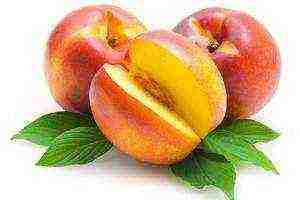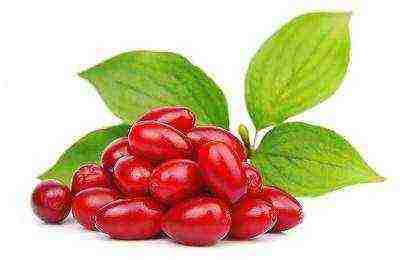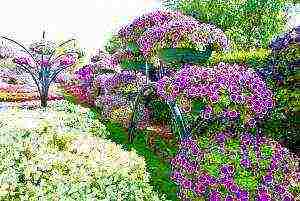Content
- 1 Early maturing honeysuckle varieties
- 2 Medium ripening honeysuckle varieties
- 3 Late-ripening honeysuckle varieties
- 4 What is honeysuckle and its features
- 5 Where and when is it better to plant a plant
- 6 Neighbors for honeysuckle
- 7 Sapling selection
- 8 Planting honeysuckle correctly
- 9 Transplanting a bush to a new location
- 10 Planting honeysuckle in the regions
- 11 Gardeners reviews
- 12 Edible honeysuckle - full description and variety of varieties
- 13 Let's get acquainted with the varieties of honeysuckle for central Russia
- 14 Types and varieties
- 15 How to cook
- 16 Season
- 17 How to choose and store
- 18 Honeysuckle varieties
Consider the varieties of honeysuckle for cultivation in the Republic of Belarus.
Loading …
View all polls
Early maturing honeysuckle varieties
Blue spindle
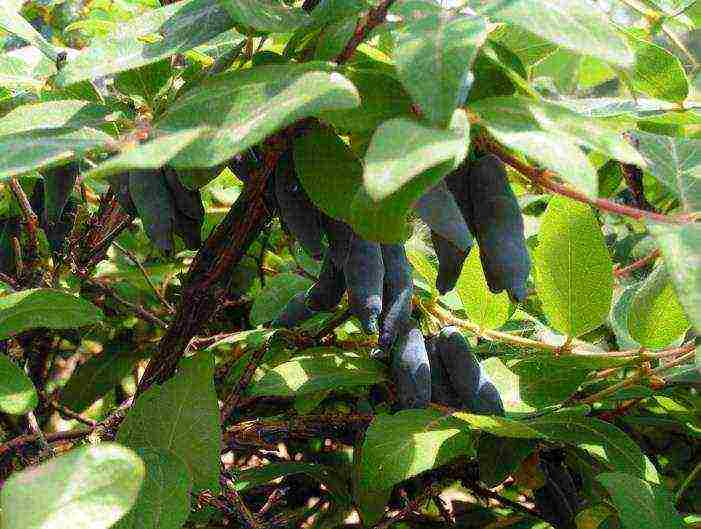
Variety universal purpose. Average yield - 1.2 kg / bush.
Biological features: the best pollinators are Blue Bird, Morena, Tomichka.
Bush vigorous, with a spreading, rounded crown. Shoots are thin. Leaves are dark green, large.
Fruit elongated fusiform (average weight - 0.90 g), sweet-sour taste, with bitterness (tasting score - 4.1 points).
Consumption period: June July.
Dignity: The variety is winter-hardy, moderately affected by powdery mildew.
Flaw: Fruit crumbling during ripening is strong.
ZINRI
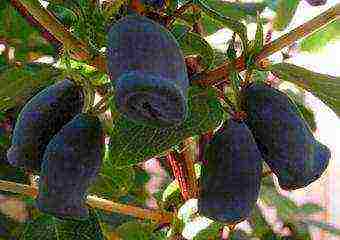
Variety universal purpose, insteps into fruiting in the 3rd year after planting in the garden.
Bush medium-sized.
Fruit cylindrical, large. (average weight - 1.1 g). The taste is sweet and refreshing. Tasting score - 5 points.
Consumption period: June July.
Dignity: Winter-hardy variety, productive (2.5 kg / bush). Fruit shedding is absent.
Flaw: Relatively resistant to fungal diseases.
Bell
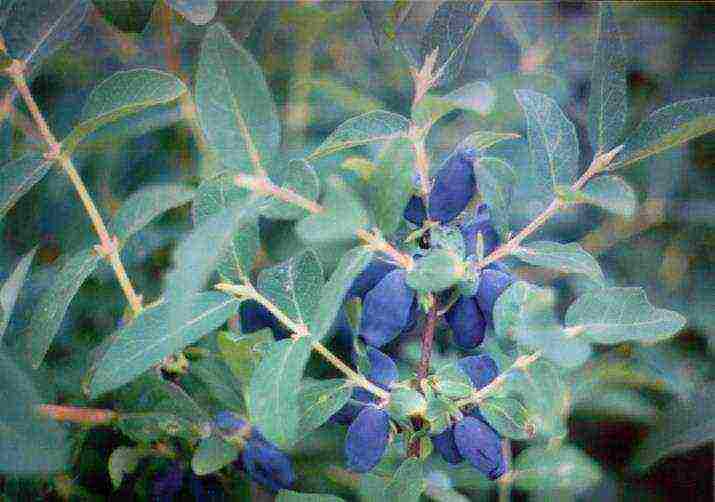
Variety universal purpose, average yield –1.0 kg / bush.
Biological features: self-infertile.
Bush vigorous.
Fruit average size (average weight - 0.70 g). The taste is sweet and sour, dessert, with a strong aroma (tasting score - 4.2 points).
Consumption period: June July.
Dignity: Winter-hardy variety. The shedding rate of fruits is average. The variety is slightly affected by powdery mildew. The variety has good transportability.
Gourmet
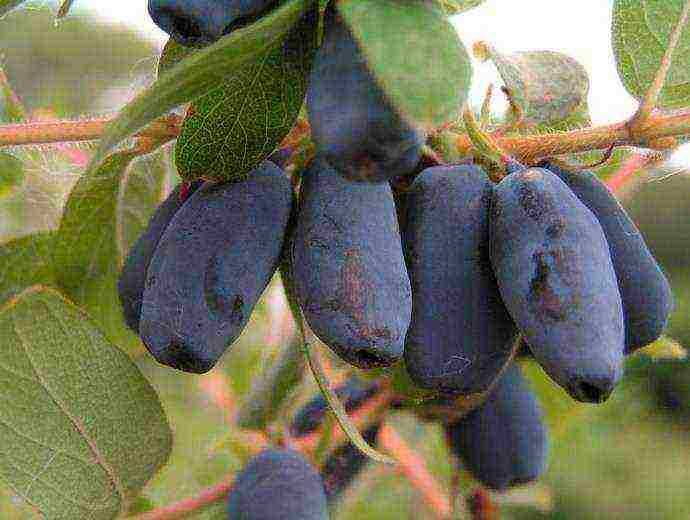
Variety universal purpose. Average yield - 1.2 kg / bush.
Biological features: self-infertile.
Bush medium-sized, dense, compact, with an oval crown.
Fruit the shape is elongated-oval, with a flat top (average weight - 0.73 g).The taste is sweet and sour, without bitterness (tasting score - 4.2 points).
Consumption period: June July.
Dignity: The variety is winter-hardy. Fruit crumbling during ripening is weak.
Flaw: The variety is relatively resistant to powdery mildew.
Nizhny Novgorod early
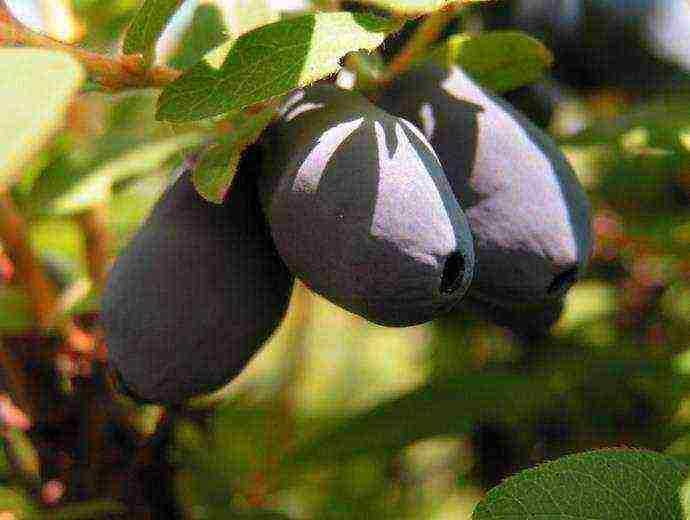
Variety universal purpose.
Biological features: the best pollinators are Fortuna, Moskovskaya-23.
Bush vigorous, with a spreading, rounded crown.
Fruit almost cylindrical (average weight - 0.83 g), sweet-sour taste, with a refreshing aroma (tasting score - 4.1 points).
Consumption period: June July.
Dignity: The variety is winter-hardy, high-yielding (1.8 kg / bush).
Flaw: Fruit crumbling during ripening is strong. The variety is relatively resistant to powdery mildew.
Medium ripening honeysuckle varieties
LARGE
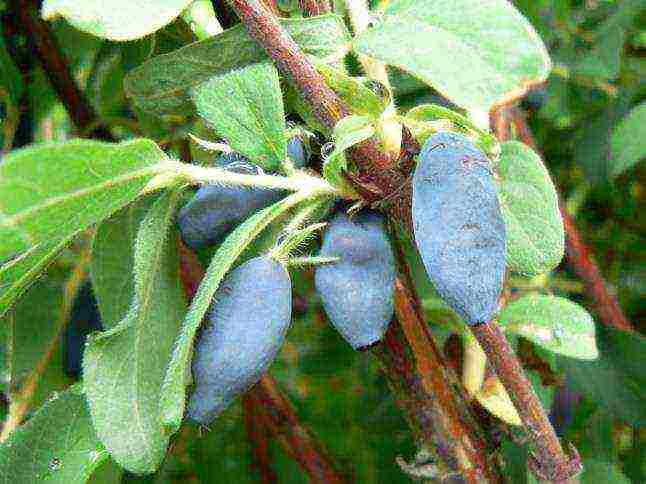
Variety universal purpose.
Biological features: begins to bear fruit in the 3-4th year after planting.
Bush vigorous, strongly thickened crown, reverse conical.
Fruit cylindrical, slightly elongated at the base, with a flat top, slightly hilly surface (average fruit weight - 0.7-0.9 g). Dessert taste, sweet and sour, with a pleasant aroma (4.5 points).
Dignity: The variety is winter-hardy. productive (1.6 kg / bush). The crumbling rate of fruits during ripening is average.
Flaw: The variety is relatively resistant to powdery mildew.
Jug-shaped

Variety universal purpose. Average yield - 0.7-1.0 kg / bush.
Biological features: self-infertile.
Bush vigorous, dense, rounded crown.
Fruit above average (average weight - 0.80 g). The taste is sweet and sour, with aroma (tasting score - 4.0 points).
Dignity: The variety is winter-hardy. productive (1.6 kg / bush). The crumbling rate of fruits during ripening is average.
Flaw: The variety is relatively resistant to powdery mildew.
Pavlovskaya
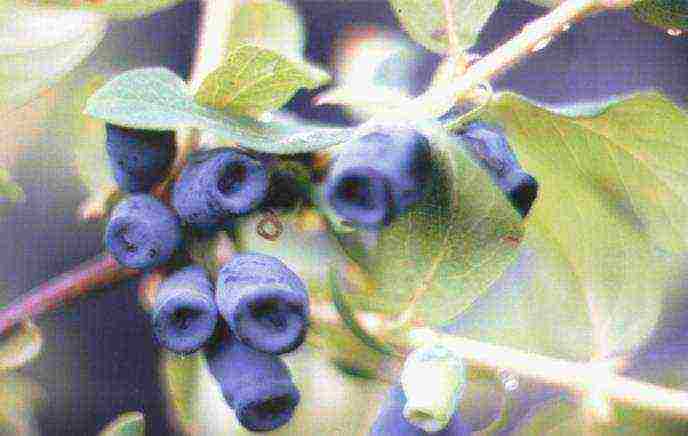
Variety dessert purpose.
Biological features: self-infertile. The best pollinators are Blue Spindle, Tomichka, Vasyugan, Blue Bird.
Bush vigorous, dense, rounded crown.
Fruit large (average weight - 0.93 g). The taste is sweet and sour, with aroma (tasting score - 4.5 points).
Dignity: The variety is winter-hardy. productive (1.2-1.8 kg / bush). it is characterized by amicability of ripening and weak crumbling of ripe fruits. Good transportability.
Flaw: The variety is relatively resistant to powdery mildew.
Titmouse
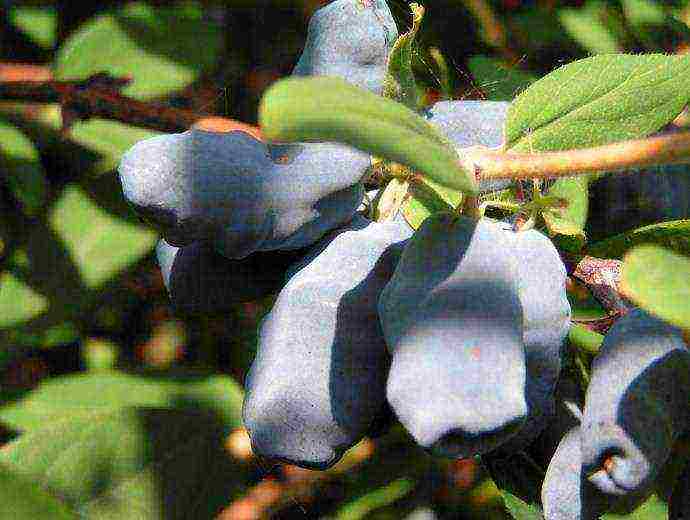
Variety universal purpose. Average yield - 1.5 kg / bush.
Biological features: the best pollinators are Fortuna, Moskovskaya-23.
Bush vigorous, with a spreading, rounded crown.
Fruit almost cylindrical (average weight - 0.84 g). The taste is sweet and sour, with a refreshing aroma (tasting score - 4.1 points).
Dignity: The variety is winter-hardy. Fruit crumbling during ripening is weak.
Flaw: The variety is relatively resistant to powdery mildew.
Late-ripening honeysuckle varieties
Vasilievskaya

Variety universal purpose. Average yield - 0.7-0.9 kg / bush.
Bush vigorous, the crown is rather sparse, broadly rounded, spreading.
Fruit average size (average weight - 0.70 g).
Dignity: The variety is winter-hardy. Fruit crumbling during ripening is weak.
Flaw: The variety is relatively resistant to powdery mildew.
On a note: Honeysuckle fruits strengthen the walls of blood vessels, muscles and nervous tissue. In folk medicine, they are used for diseases of the stomach, liver, gallbladder, hypertension, cardiovascular failure, malaria, anemia. They also have bactericidal properties. With juice of berries, ulcers, lichens are treated, a decoction of berries and leaves is used for rinsing the mouth and throat, for stomatitis, pharyngitis and sore throat, tincture of flowers - for inflammation of the bladder, infusion of leaves - for conjunctivitis.
Material prepared by: gardening specialist Buinovsky O.I.
(Number of views - 4 086, today - 1)
Honeysuckle is an upright or creeping shrub. Currently, more than 190 species of honeysuckle are known, among which there are shrubs that bear fruit (edible or poisonous), as well as a variety of honeysuckle, used as an ornamental plant. Growing honeysuckle has become a favorite pastime for many gardeners. To get a good harvest, you need to select plant varieties taking into account the region and follow a few simple planting and care rules.
What is honeysuckle and its features
Most often, blue honeysuckle is grown in gardens and vegetable gardens - it is a deciduous shrub that grows up to 2.5 meters in height, with beautiful elliptical green leaves and spindle-shaped dark blue berries with a bluish bloom. Edible honeysuckle began to be grown on the territory of Russia in the 20th century, but even now not all gardeners know about it.
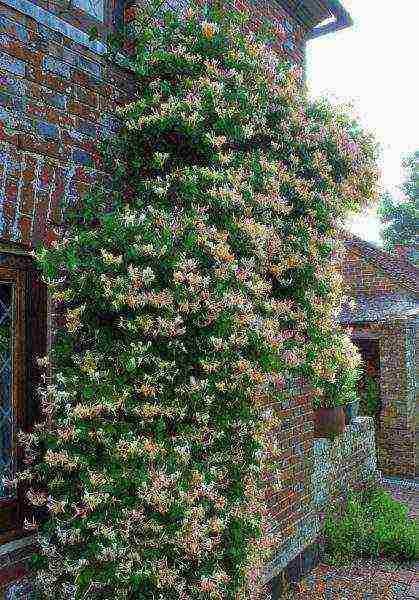
Honeysuckle honeysuckle is used as an ornamental plant
Honeysuckle gives the earliest berries: it ripens in early June, even earlier than garden strawberries. While older varieties are reminiscent of blueberries and have a bitter taste, most modern varieties lack this bitterness and contain a large amount of sugars. The peculiarity of honeysuckle berries in its ability to clean capillaries, therefore, it is of the greatest value for people of the older generation, however, it is recommended for use in food for everyone, since it has no contraindications.
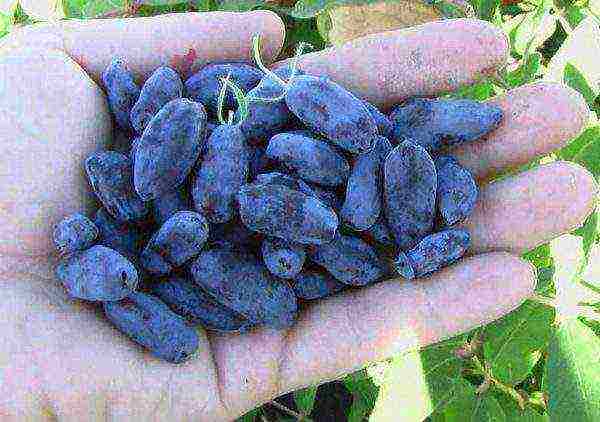
A handful of honeysuckle berries eaten for breakfast provides the body with a daily intake of iron and B vitamins
Honeysuckle fruits contain 8% sugar, from 1 to 5 organic acids, pectins, tannins, P-active compounds (antacyans, catechins), provitamins A1, B2, B1, vitamin C, as well as various trace elements: calcium, magnesium, phosphorus , sodium, copper, iron, iodine, aluminum, barium, silicon, strontium, manganese.
Features of honeysuckle:
- Honeysuckle is a cross-pollinated plant, that is, several bushes of different varieties are needed for fruiting. For example, the Bakcharsky giant variety is the best pollinator for the Pride Bakchara, Silginka, Chulymskaya varieties. When planting several bushes of the same variety, you will get abundant flowering without berries.

For good fruiting, it is necessary to plant nearby honeysuckle bushes of various varieties
- The second characteristic of honeysuckle is the flaking of the bark. Already on young branches, cracking and subsequent lagging of the bark from the trunk are noticeable.
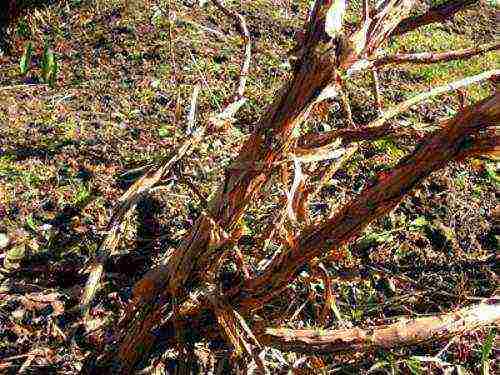
Even young twigs of honeysuckle can peel off the bark.
- Honeysuckle yields only on young shoots, so you should not get carried away with pruning if you do not want to be left without berries.
- A honeysuckle bush can grow in one place for up to 20 years and can withstand a drop in temperature in winter to -40 ° C.
- It blooms very first, and the flowers can withstand frosts down to -6 oC.

Honeysuckle blooms as the very first of the shrubs, it is an excellent honey plant
Video: honeysuckle from the Bachkar nursery
Where and when is it better to plant a plant
Honeysuckle buds bloom in late April - early May, so when planting in spring, you should adhere to these dates. If you got the seedling very early, when the soil on the site is not yet ready, then you can plant it in a large pot and then transfer it into the planting pit. If a seedling with a closed root system (in a pot), then you can plant the whole season.

It is better to buy honeysuckle seedlings with a closed root system.
Autumn planting of honeysuckle begins in mid-September and, depending on the region of residence, can last until mid-November.
Video: planting honeysuckle varieties Daughter of a Giant
Seat selection
When choosing a landing site, you need to consider the following features:
- Honeysuckle is considered an unpretentious shrub, especially for the northern regions of Russia, where there are frequent rains and not very hot summers. In such areas, honeysuckle is best planted in sunny areas without constantly blowing winds.
- In the southern regions, it is better to plant honeysuckle in partial shade or in the sun, but with constant watering.In dry areas without watering, the bush will be short, weak and with a small number of berries.
- Swampy areas with very close groundwater or acidic soil will not work either. If it is impossible to find a more favorable place, plant it on high ridges.
- The soil under the honeysuckle should be light, fertile, neutral acidity.
Honeysuckle planting scheme
Since honeysuckle is cross-pollinated, the bushes should be placed side by side. Three or four bushes can be planted in a row, and more can be planted in groups in several rows.
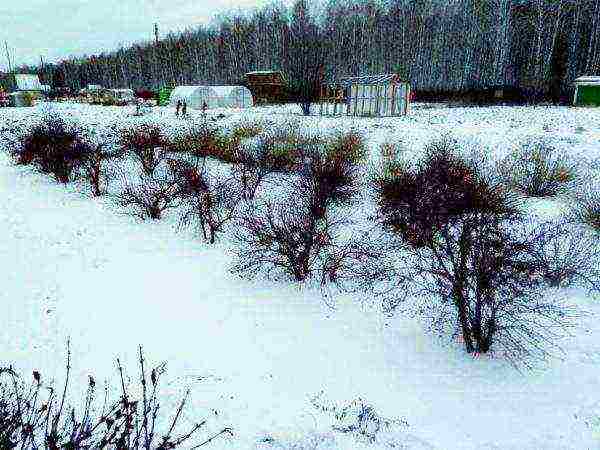
A small number of honeysuckle bushes can be planted in a row, keeping the distance between the plants 1-2 meters
The distance between honeysuckle bushes in planting will depend on the variety, since there are both large spreading bushes and more compact ones. But most often, from 100 to 120 cm is left between the bushes, the same amount is worth retreating from the fence. When planting in multiple rows, make up to 2 meters between rows. When using honeysuckle as a hedge, the holes are placed at a distance of 50 cm from each other.
Neighbors for honeysuckle
Honeysuckle is rarely damaged by various pests, so it can be planted next to other shrubs, but it especially likes the neighborhood with black currants. In the near-stem circle, you should also not plant any plants, since the root system of honeysuckle is superficial.
Sapling selection
On sale you can often find both seedlings from local nurseries and imported ones. However, the new and the best are the varieties bred in the Bakcharsky nursery located near Tomsk. Plants 2-3 years old with a good root system are considered the most suitable seedlings. Before planting, the roots should be soaked in water for 1-2 hours with diluted Kornevin or HB 101.
Planting honeysuckle correctly
Due to the structure of the root system, honeysuckle is planted slightly differently than other shrubs:
- The planting hole is dug shallow and wide: 35 * 50 cm, the roots of perennial weeds are carefully selected.
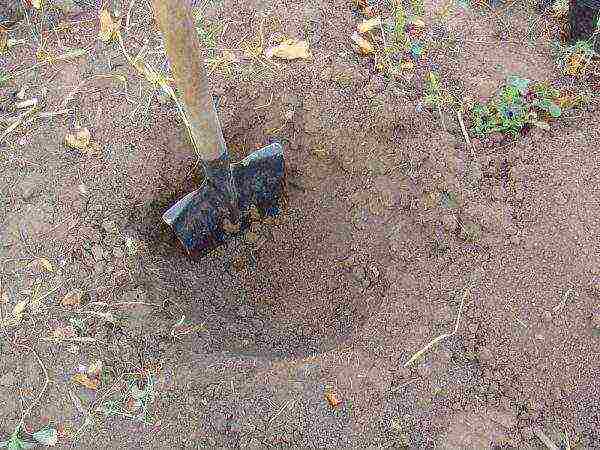
A planting pit is made 50-60 cm wide, and 35 cm deep
- Pour a bucket of compost or humus, 100 grams of superphosphate and half a liter of ash. On heavy clay soils, additionally add 1 bucket of sand, on acidic - from 200 to 400 grams of lime, and on sandy - coconut substrate or hydrogel to retain moisture.

Mineral fertilizers, humus, ash are introduced into the planting pit
- A dense mound is made in the pit, on which the seedling is placed so that the root collar is at the level of the soil. If a seedling with an open root system, then the roots must be spread out along the slopes of the hill. A seedling with a closed root system must be removed from the pot and, slightly straightening the roots, put on a hill or in a planting hole.
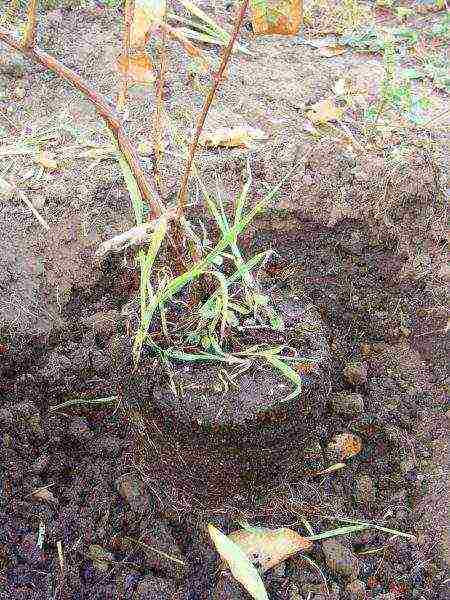
A seedling with a closed root system can simply be placed in the planting hole, while the root collar should be at ground level
- We fill the hole with soil and tamp it, pressing the soil to the roots.
- Pour 1-2 buckets of water on top and immediately mulch with grass, straw, wood chips, newspaper, cardboard or just dry soil. This stage is very important, as the soil should not dry out.
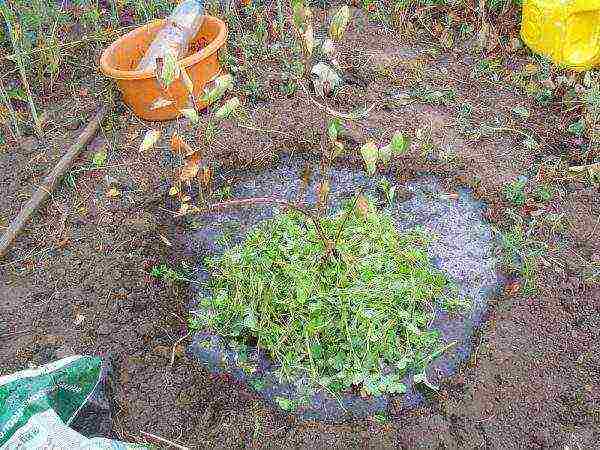
The planted honeysuckle should be mulched immediately with grass.
Transplanting a bush to a new location
Honeysuckle tolerates transplantation well. The best time for this is from July to October. Young small bushes can be dug out with a large clod of earth and transferred to a new place, while large bushes should be trimmed first, shortened or cut out old branches, and only then transplanted.
Planting honeysuckle in the regions
Depending on where you live, there may be some differences in the planting of honeysuckle.
Landing in Belarus
The desired date for planting honeysuckle in the Republic of Belarus is the end of summer and autumn. The place of cultivation is the sun, it will bear little fruit in the shade. The zoned varieties include Goluboe Vereteno, Lakomka, Nizhegorodskaya early, Morena and Vasilievskaya.Due to the long and warm autumn, honeysuckle in Belarus often blooms in November, and sometimes in winter, so it is recommended to choose varieties with a long dormant period.
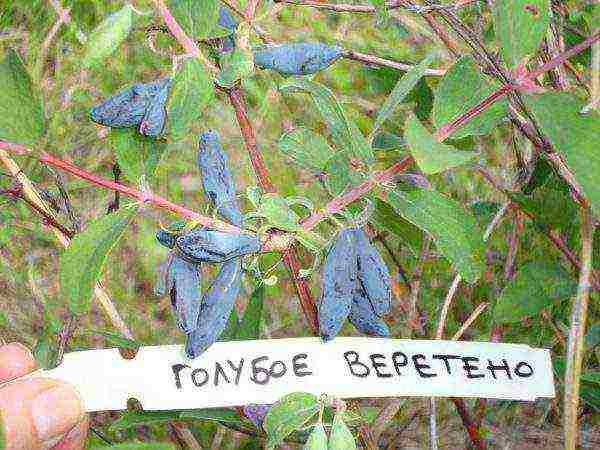
Honeysuckle variety Blue Spindle is distinguished by medium-sized berries of a sour-sweet taste with a slight bitterness
Landing in the suburbs
For landing, a bright and sunny place is chosen, with neutral soil and no blowing winds. The best varieties for the Moscow region are Chosen One, Nymph, Morena, Silginka.

Honeysuckle varieties Silginka - one of the best options for planting in the Moscow region
Landing in Siberia
For planting honeysuckle in Siberia, you should choose three-year-old seedlings - they are better acclimatized. The planting pit is prepared in advance, and if there is close groundwater, drainage is made from broken bricks or cobblestones. In this case, the hole itself must be dug at least 50 cm deep. The best time to plant honeysuckle is also considered early autumn, and in spring it is good to plant in rainy weather or with constant watering.
For a successful wintering in the Siberian region, it is impossible to feed the honeysuckle with nitrogen fertilizers after mid-June. They make exclusively potassium-phosphorus fertilizing, and it is even better to use ash. Suitable varieties are Berel, Fire Opal, Sirius, Blue Spindle, Cinderella, Blue Bird, Iliada.
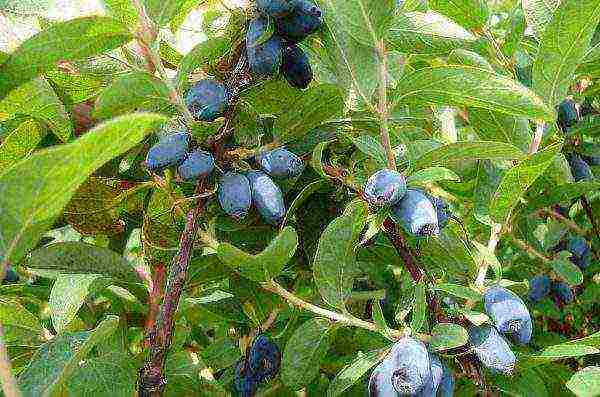
Bluebird - a variety of honeysuckle with early ripening fruits
Landing in the Urals
In the Urals, honeysuckle also prefers to grow in the sun, with the exception of the Southern Urals, where in summer the soil temperature can heat up to 50 ° C - in such areas it should be planted in partial shade, but not in full shade from a house or a barn. In especially hot years, you can stretch a construction mesh over the plantings, which will reduce the energy of the sun, and the honeysuckle will be good enough. In summer, in arid places, watering is required, especially in early June, when the berries begin to sing. The best varieties include the following: Yugan, Kamchadalka, Bakcharsky giant, Bakcharskaya, Maria, Nymph, Blue spindle, Blue bird, Titmouse.
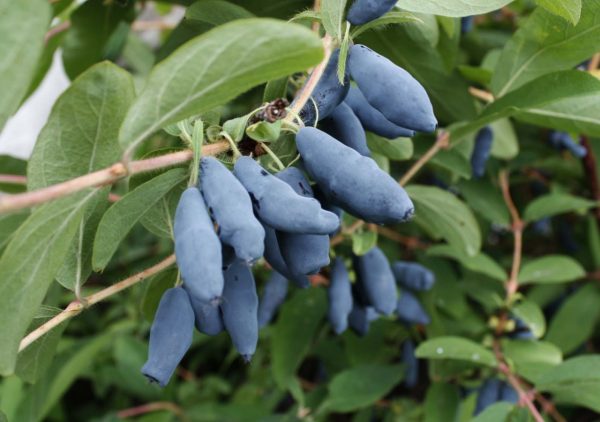
The Bachkarskaya honeysuckle variety is resistant to temperature fluctuations in central Russia and the Urals
Honeysuckle does not need shelter for the winter.
Gardeners reviews
Honeysuckle is rightfully considered one of the most useful berries, you can make wonderful jams, jams, compotes from it. Berries are eaten fresh, frozen for the winter, ground with sugar. When planting, be sure to take into account the peculiarity of honeysuckle to bear fruit only when cross-pollinated with other varieties of this plant and plant at least three bushes.
Hello, my name is Irina, I am 33 years old. I love my collection of hippeastrum very much, but I do not offend other flowers either. Rate the article:
(1 vote, average: 5 out of 5)
Which berry ripens earlier than others? Strawberry? No, honeysuckle! For many gardeners, it is still a wonder, nevertheless, it was known to European naturalists already in the 16th century. True, at that time no one considered it as a berry - only as an ornamental shrub. And although honeysuckle cannot compete with roses in beauty, it will overshadow it with its delicate refined aroma.
Tatiana Kurlovich, candidate of biological sciences, head. sector "Zhuravinka" of the laboratory of introduction and technology of berry plants of the Central Botanical Garden of the National Academy of Sciences of Belarus, honeysuckle is a favorite shrub. For three very good reasons. Firstly, honeysuckle is the most winter-hardy: the shrub can withstand frosts down to minus 50, and flowers - up to minus 5 - 7 degrees. There are no leaves, and the shrub is all in bloom. Secondly, the berries ripen at a record early date. Thirdly, the fruit tastes like blueberries. Since the berries ripen at the same time and crumble very quickly, some gardeners consider this a disadvantage. But, by leveling the ground under the bush and spreading cellophane, this minus can be easily turned into a plus: you don't even need to pick the crop.
What gardener doesn't dream of extending the fresh berry season? And not in the direction of late autumn, already rich in vegetables and fruits, but in the direction of early summer, when vitamins are in great deficit. And it is precisely for the very early ripening that honeysuckle is valued: it ripens 7 - 16 days before the strawberries and a month before the currants.Edible honeysuckle, or blue-fruit, as Siberians fondly call it, has stepped into the culture from the taiga. In nature, it has a wide variety of relatives: viburnum, elderberry and even snowberry - they all belong to the large family of honeysuckle.
As often happens in our homeland, at first, honeysuckle was loved not for its taste, but for its color. This unpretentious shrub appeared in St. Petersburg in the 18th century. Numerous gardens and parks were decorated with it - it blooms too beautifully.
“Thanks to tasty and healthy berries, 6 plant species have received the greatest economic value,” says Tatiana Kurlovich. - This is edible honeysuckle, Kamchatka, Altai, Turchaninov, Regel and Pallas. On their basis, more than 80 varieties of edible honeysuckle have been obtained.
Honeysuckle has the shortest period from bud opening to fruit ripening - 45 - 50 days. For comparison: for currants - 90 - 100, for sea buckthorn and rose hips - 100 - 120. As a rule, the bush has enough heat and precipitation for normal growth. Especially if the winter was snowy (like this one).
Honeysuckle blooms in early or mid-May. Her flowers are beautiful, light yellow or yellow, fragrant, collected in 2 - 4 or more in one inflorescence. Despite the fact that they are bisexual, pollen matures later than pistils, so the plant is poorly pollinated with its pollen. As in the case of any cross-pollinated plant, for better pollination and setting of honeysuckle fruits, it is necessary to have at least two (and preferably 3-4) different varieties on the site. Growing only one bush or several of the same variety, you will observe abundant flowering and ... a complete absence of fruits every year.
Honeysuckle blooms for a long time, 20 - 28 days: it all depends on the weather. Due to this, a significant part of the flowers "leaves" from the destructive return cold and early spring frosts. The earlier the plant blooms, the earlier the fruits will ripen.
The berries are varied in shape and color: dark purple or black with a strong bluish bloom, elongated, and also similar to a cylinder, barrel, bell, spindle, jug ...
Honeysuckle grows well and bears fruit in one place for 15 - 20 years. If she likes it there, of course. She is a light-loving culture: in partial shade under the crowns of trees, the berries become smaller. It is not worth planting it in depressions, so-called "saucers", where cold air accumulates, water stagnates or groundwater comes close.
Since the berries are poured and ripen in a very short time, the soil must be fertile enough. The roots of the plant are located at the very surface of the earth, and therefore suffer from the slightest fluctuations in temperature and humidity. To prevent this from happening, it is best to mulch the soil around the bush within a radius of 70 cm with a thick layer of organic matter - humus, peat, compost, straw, grass. Organic fertilizing before and after flowering will only benefit the crop.
If in the middle of the twentieth century they talked about the blueberry as a kind of outlandish culture, today this shrub is becoming more and more popular both in Belarus and abroad. In Europe, plantations of edible honeysuckle have already been established not for amateur, but for industrial value.
Honeysuckle does not fail after the most severe frosts, it also withstands spring morning frosts down to minus 8 degrees. Isn't that tenacity? Only a month passes from flowering to ripe fruits - is this not early maturity? If you still haven't feasted on berries with a piquant bitterness, then you have lost a lot! You should definitely start this berry culture in your garden, advises Tatiana Vladimirovna.
Beginning to grow honeysuckle, have patience: in the first 3 - 4 years, most varieties grow very slowly, only by the fourth year reaching 70 - 80 cm in height, and a little more than a meter in diameter. Don't worry, everything is in order with the plant: all efforts are thrown into the development of the roots. Then, intensive growth will begin and the aerial part.And by the age of 8 - 10 the bushes of vigorous forms will already be 2.5 - 3 m in height. Calculations of the potential productivity made by breeders show that, depending on the variety, up to 12 kg of berries can be obtained from the bush.
The best time to plant honeysuckle is early fall. In the spring, serious difficulties arise: the buds start growing early, and the earth is not yet ready for digging.
When choosing a plot for cultivation, remember that honeysuckle, although undemanding to the soil, grows poorly on heavy clay or light sandy soils. Dig holes for planting small: 30 - 50 cm deep and 50 - 60 cm wide. In each add 2 - 3 kg of rotted manure, mix it well with the ground, add 20 - 40 g of nitrogen, 50 - 60 g of potash and 60 - 70 phosphorus fertilizers.
Gently spread the roots and cover with light, well-fertilized soil with humus. Embed the root collar by 2 - 3 cm. Water the plantings abundantly, and then mulch with humus or compost soil. If the weather is dry, water the seedlings every 2 to 3 days.
Honeysuckle should be planted at a distance of 1.5 - 2 m from each other in a row, and there should be at least 2 - 3 m between rows.With a denser planting, the plants close together and create a solid green strip, which lowers their yield, makes it difficult to pick berries, tillage and care. Rows are best placed from south to north.
Caring for the bushes is reduced to loosening the soil around them and killing weeds.
In the year of planting in autumn or early winter, to avoid breaking branches in heavy snow, tie the bushes with strong twine.
During the season, honeysuckle needs to be fed three times. The first time is in early spring to ensure good annual growth and normal budding. We add 1 - 2 buckets of humus or compost mixed with 50 g of nitroammophoska or superphosphate under the bush. The second feeding with complex fertilizers is combined with watering and carried out in June. The third - in early October - for excellent wintering. Under the digging, we add 15 g of double superphosphate and potassium salt per 1 sq. m. Once every 2 - 3 years in the fall we give organic matter: 10 - 12 kg per one bush.
Honeysuckle, one might say, practically does not suffer from pests. Although among her enemies there are sawflies, leafworms, scale insects and moths, like currants. And therefore it is necessary to fight them in the same way. But it is best to use vegetable infusions of tomato or potato tops with the addition of tobacco and laundry soap.
Confiture
Crush washed berries with a wooden pestle and mix with sugar (1: 1). After it has melted, bring the mixture to a boil and place in the jars. The jam turns out to be jelly-like.
Glazed berries
Mash one egg white with a glass of sugar and 1 tbsp. l. lemon juice. When the mass thickens a little, dip the berries in it so that they are completely covered with glaze. After that, put them on a dish and let dry, and then put them in jars.
Marmalade
Rub the honeysuckle through a sieve, add granulated sugar (for 1 kg of berries - 600 g) and cook until the mass begins to lag behind the dishes. Then pour the mixture onto a dish soaked in cold water. After cooling the marmalade, cut into pieces and put in jars.
Jam
Prepare the berries, boil sugar syrup (for 1 kg of berries - 1.5 kg of sugar), pour them over the berries and leave for 5-6 hours, then cook until tender in one go, cool and put in jars.
The juice
Sort the fruits of the same ripeness, crush and fill with water (one glass per 1 kg). Put on fire and, bringing the temperature to 600C, warm up for 10 minutes. Then press or rub through a sieve. Boil the juice and roll up.
Abnormally warm October and November sometimes disrupt the natural rhythm of plants. And the fact that edible honeysuckle blooms in November is normal. The generative buds of this culture have too short a dormant period. Here they are, awakened by the warm autumn sun, and wake up.If the weather permits, they can bloom in winter. So, for example, it was in 2008.
Of course, there is little good in autumn bloom. Is it just extracurricular beauty. The flowers will disappear anyway, so do not rush to pick them off. They will not bloom again next year. Such out-of-season flowering will not seriously affect the winter hardiness of the plant. Natural selection can be considered. Of course, next year, honeysuckle will bear fewer fruits, but they will be larger.
In order not to worry about the harvest once again, it is best to plant plants with a long dormant period.
Help "SB"
Honeysuckle varieties, zoned in Belarus:
"Blue spindle", "early Nizhny Novgorod", "gourmet", "Vasilievskaya", "moraine", "large-fruited".
Species varieties of edible honeysuckle are propagated by seeds and semi-lignified cuttings, varietal varieties - only by cuttings.
Seeds are sown before winter or spring (in this case, stratification is necessary). But very often, during seed reproduction, the properties of the mother bush are not transmitted to the offspring.
It can also be propagated by layering, but green cuttings are considered the most common and effective method. You can start harvesting and planting green cuttings with the appearance of the first berries and until July 5. For cuttings, the tops of the shoots are used. They are cut into a length of 7 - 12 cm with two or three pairs of leaves, which, in order to reduce evaporation, are cut in half of the leaf.
Cuttings are planted obliquely, half buried, in a specially prepared substrate from a mixture of peat and river sand (1: 3) in the shade under a film or plastic bottles. This is the best option. The main condition for rooting cuttings is frequent (4 - 5 times a day) watering, especially in the first week and a half after planting.
To avoid the death of cuttings, on very hot, windless days, it is necessary to raise the film and ventilate the greenhouse or boxes for a short time. In a humid greenhouse in warm weather, after 8 - 10 days, nodules (callus) form at the lower end of the cutting, and after another 10 - 12 days, roots begin to appear.
For some gardeners ... glass jars become greenhouses. They plant cuttings in a pre-prepared bed, water them abundantly and cover them with jars. Then, without removing the dishes, water abundantly every two to three days. After 30 - 40 days, the jars are removed, but previously (several days before the deadline) they are gradually raised, placing sticks of different thicknesses on one side. This is necessary in order to accustom rooted cuttings to fresh air.
In early August, a month and a half before the onset of the first autumn frosts, rooted cuttings must be planted either in pots or in a school for growing at a distance of 8x8 cm from each other. After planting, they must be watered abundantly through a fine strainer and mulched with peat, fine humus or sifted compost soil. With the onset of the first frost, it will not be superfluous to cover the bed with cuttings for the winter with spruce branches or a dry leaf. In the spring of next year, remove the shelter, and loosen the soil on the bed, if it is compacted, slightly and shallowly, so as not to damage the roots. Then feed: add 1 sq. m 1 st. l. or a matchbox of nitroammophoska. And after a week or two, water with diluted slurry or bird droppings (1: 8).
The next year, by the fall, the plants will be ready for planting in a permanent place.
Spring is pruning time. But pay attention to the fact that the tops of the honeysuckle are not cut off! It is in them that there are most of the buds with the rudiments of flowers, removing which we will reduce the yield.
Many people believe that honeysuckle does not need pruning at all until 7-10 years old. Some prune after planting and then trim the bushes like hedges.
To make the pruning techniques more understandable, let's follow the development of the fruit buds of the bush.
On the lateral shoots of the central branch and on the skeletal axes in the lowest part, there are growth buds, often solitary. In the middle and upper parts, they are mixed, that is, giving flowers and shoots upon awakening.
After two or three years of fruiting, the tops thicken, and at the bottom the branches become bare, and the shoots of restoration grow from them. During the summer, they reach the top of the bush and stop growing. And again, in the upper and middle parts of these shoots, mixed and growth buds are laid, and at the base - only growth buds.
Honeysuckle bushes over 6 years old require sanitary pruning - removal of diseased, broken, dried branches. First of all, cut off the branches of the lower tier, which lie on the ground, interfere with care and do not bear fruit. In adult bushes, thin out the aging part of the crown with small dried branches every 2 - 3 years, leaving no more than 5 powerful trunks. For very old bushes, pruning "on a stump" is possible at a height of 30 - 40 cm from the soil level. Next spring, the first shoots will appear on low stumps, and the bush will begin to recover.
In general, caring for adult honeysuckle is reduced to cutting dry branches and correcting the floors.
Rejuvenating thinning pruning is recommended for 8-10 years after planting. Detailed anti-aging pruning - once every 3-4 years.
On mature fruiting bushes, the bark is very often exfoliated and gray-brown stripes hang down. You should not worry, this is not a disease, but a biological feature of the plant.
The honeysuckle got its name, most likely, from the old Belarusian word "zhymalats" - "a plant with strong veins". And the second name of the culture - tree trunk - speaks for itself: in the old days its branches were used to make bobbins for weaving lace, whips, and ramrods.
Honeysuckle is not only an ornamental, but also a gas-resistant shrub, therefore it is very promising for landscaping cities and towns. Plus, it's an excellent honey plant.
The advantage of edible honeysuckle is not only the earliest ripening of berries, but also an extremely rich set of healing substances in them. All researchers are unanimous in the opinion: the plant is extremely useful. In terms of the amount of vitamin C, honeysuckle surpasses lemon and strawberries (100 g is the daily norm of ascorbic acid), and in terms of some macro- and microelements it has no equal in nature.
If you eat honeysuckle regularly, you can significantly strengthen the capillaries and lower blood pressure. Pectin substances, which are so rich in fruits, protect the body from salts of heavy metals, with which it is very difficult for residents of cities and territories contaminated with radionuclides to fight.
Honeysuckle is especially useful for cardiovascular diseases, hypertension, atherosclerosis, for the treatment of the liver and gallbladder. It is also actively used for gastritis, duodenal ulcer, anemia. Berries are diuretic, astringent and anti-inflammatory.
A decoction of berries strengthens memory. To do this, ripe fruits are crumpled with a crush, poured with boiling water (3 tablespoons of berries per glass) and insisted for 2 hours in a dark place, after which they filter and drink a third of the glass three times a day before meals.
For sore throats and colds, a decoction of the leaves, using their antiseptic properties, gargle. Wounds and burns are washed with infusion of leaves. Sprinkle wounds with dry crushed leaves for faster healing.
A decoction of twigs with leaves has a strong diuretic effect and is considered a good remedy for edema of any origin. It is prepared at the rate of 1 teaspoon per glass of water, boiled over low heat for 20-30 minutes, filtered and drunk by 1 tablespoon 3-4 times a day. This composition also helps with severe pain in the gastrointestinal tract. A bath of young sprigs of honeysuckle helps with gout and rheumatism.
Honeysuckle also helps with frequent nosebleeds: eat berries more often, including dried ones.They are a source of antibiotics. Honeysuckle is also shown on fasting days with obesity, overweight and metabolic disorders.
Not only the fruits themselves, but also the jam have healing properties. It is an excellent antipyretic agent.
If you want to maintain high efficiency, vigor and good mood throughout the day, start your day with a handful of mashed honeysuckle berries, lightly sprinkled with sugar.
Attention: those who suffer from gastritis with high acidity, as well as stomach and duodenal ulcers, should not get carried away with honeysuckle. Sour berries can exacerbate the disease.
Have you noticed a mistake? Please select it and press Ctrl + Enter
Did you like the material? Rate it.
Edible honeysuckle - full description and variety of varieties
Similar articles
Elena! Thank you very much for the interesting and useful information. Tell me, if possible, how to get honeysuckle seedlings (I am also from Krasnoyarsk). All the best and good luck! Best regards, Tatiana."Blue Bird"Dried honeysuckle fruits retain all their valuable qualities.
Botanical description of edible honeysuckle
Honeysuckle berries should not be kept in the refrigerator for a long time: they lose their freshness a few days after purchase. If there is a need to preserve honeysuckle for autumn and winter, it is better to grind it with sugar, wither or freeze it.
Kamchatka honeysuckleWeak shedding of fruits;
In the middle zone of our country, the first berries can be picked in June, when strawberries and raspberries are still at the flowering stage.
Content of nutrients
High yield
Or early spring. Rejuvenation of old honeysuckle bushes that have reached the age of 20 years is carried out by cutting off their lower branches at a level of half a meter from the ground.Honeysuckle berries of all varieties, possessing a blue color, contain a large amount of anthocyanins, which are powerful antioxidants. They help cleanse the body of heavy metal compounds and free radicals, which makes it possible to increase metabolic processes, prolong youth and prevent cancer.The dream of any gardener is to grow a garden on his backyard that will delight not only with the beauty and fragrance of flowering plants, but also bring health benefits. That is why many now approach this issue very thoughtfully and plant medicinal plants along with traditional fruit trees and shrubs, thereby creating a real green pharmacy in the beds.
Healing properties
- Good day, everyone. Tell me, please, is a warm climate suitable for honeysuckle? I want to buy for my parents. They live in the south.Descended from its wild Kamchatka counterpart. The selection of this crop was carried out at the Research Institute of Horticulture in Siberia. "Blue Bird" - honeysuckle of early ripening, very unpretentious and practically not susceptible to disease. The harvest begins in the 3rd year after planting; fruiting lasts 20-25 years. The shape of the crown of the shrub is round, the bush is vigorous, massive. The berries are bluish-blue, elongated, weighing 0.9-1.2 grams, with a pronounced waxy bloom. "Blue Bird" has a soft-soft taste, without sourness specific to honeysuckle. Has a high sugar content (6.4%). Productivity - from 1.5 to 2.5 kg of berries per bush.Honeysuckle
- 111
- (Lonicera kamtschatica). Of theseRequires pollinators;Resistance to pests and diseases, ease of care makes honeysuckle available to almost every summer resident. Due to its high immunity, the plant does not require chemical treatment and is a valuable product for baby food.
- (About 2 kg), it has undoubted advantages. This is primarily the size and taste of the fruit. The berries are dark blue in color, 3 cm in length and weighing 1.3 g have a delicious aroma and sweet and sour dessert taste.
- The soil should be loosened rarely and carefully so as not to disturb the root system located close to the soil surface, and in the hot season it should be watered abundantly (1 bucket of water for each bush).In dermatology, decoctions of honeysuckle flowers have also found their application asHoneysuckle is one such plant. Decorative curly varieties of honeysuckle along with their
- Laura, you know, I haven’t seen it grown here ... She needs snow, as far as I understand .., but where can we get it ?! :))
- Honeysuckle variety "Amphora"Literally burst into Russian gardens! Until 20 years ago, no one even thought of this berry as a garden plant. After all, honeysuckle is a forest dweller.Do you know what honeysuckle looks like and what is it eaten with? If not, then urgently find out: the season of honeysuckle ...
- Wild
Has a low, spreading bush, pubescent shoots;Due to the fact that the climate of central Russia is ideal for growing honeysuckle, breeders are successfully working on the creation of new and improvement of the old beloved varieties.Variety "Nymph". Small rounded bushes reach a height of one and a half meters and are highly frost-resistant. Ripening time and medium crumbling. The berries are dark blue, oblong, fusiform, about 2 cm long. The peculiarity of this variety is its sweet dessert taste and strong pleasant aroma. Productivity up to 3 kg.
Diseases that are extremely rarely exposed to edible honeysuckle include phytoviruses, spotting and powdery mildew. Bordeaux mixture helps in the fight against them for any plant varieties.
Growing honeysuckle
Antiseptic agents for treating wounds
- Medicinal properties
- Parents, where exactly, in the south? If the Rostov region or the Stavropol Territory is tolerable .. if the Crimea or the Kuban .., then it is unlikely ... Survive, it will survive .., only the fruits ... Small .., dryish and little ... Rusty will suffer, probably ...
- "Amphora"
- What does she do in our suburban areas?
Planting and leaving
00Species of honeysuckle, including crossed among themselves, selected fruitful varietiesBlack berries are distinguished by a blue tint, oval shape, sweet taste with a pleasant aroma. The variety is picky about the planting site and prefers sunny, sheltered from the wind areas. Produces well in rich soil and requires a drainage system. With a lack of moisture, the plant can shed its fruits. Therefore, the land under the honeysuckle must be mulched and irrigated in the heat.
Honeysuckle, for successful fruiting, requires proximity to a pollinator plant. It is better to choose it from varieties that are regionalized in a specific area.DecoctionAll varieties of honeysuckle can be propagated in several ways: cuttings, layering, dividing bushes and seeds.
And the treatment of various cutaneous dermatitis. In cosmetology, extracts from honeysuckle fruits are included in anti-wrinkle creams and anti-puffy eyes.
Conquer the hearts of gardeners with their beauty and enchanting scent of flowers, which makes it possible to use it in landscape design for decorating hedges and gazebos. Edible honeysuckle varieties, which are distinguished by an even wider spectrum of medicinal qualities in addition to them, have fruits of a sour-sweet taste with a huge content of healthy vitamins.Last edited on 23 July 2015, 22:46Comes from the wild Kamchatka honeysuckle and is suitable for growing in the cold regions of Russia. Medium ripening. The bush is low, up to 1.5 meters, dense, rounded crown. It is recommended to plant Amphora next to Morena, Gzhelka, Altair. "Amphora" bears fruit in the third year after planting. The berries are large, up to 2.2 cm long, have a beautiful jug-like shape and are covered with a strong skin. Perfectly transported. The fruits of "Amphora" have a sweet and sour taste with a slight bitterness.The berry is ideal for homemade preparations. Productivity - from 0.8 to 1.3 kg of fruits per bush.
• Gives us a wonderful harvest of unusually tasty, vitamin berries.
Elena Moskalenko reminds that the honeysuckle season has begun beyond the Urals and offers to cook from ...
Reproduction
Garden honeysuckle
The Blue Bird variety does not tolerate acidic soil: it develops poorly and bears fruit. To fix the problem, it is necessary to process the planting area with lime.This variety arose as a result of pollination of Smolinskaya honeysuckle. The best pollinator for Dlinnoplodnaya honeysuckle is Chelyabinka. It is advisable to plant it at the rate of one bush for ten seedlings of the main variety.... To prepare the broth, the raw honeysuckle is thoroughly crushed, poured with water (1: 10) and boiled for half an hour in a water bath. Allow the broth to cool slightly and filter. Take 100 g before meals at least three times a day.
The most common method is propagation by cuttings. It is good because it retains all the characteristics of the plant variety. When flowering ends and the first ovary appears -
A huge set of medicinal constituents of the plant made it the No. 1 remedy for restoring the body after significant physical exertion and prolonged illness.It is a perennial deciduous shrub with edible fruits, one to two meters high. The crown is dense, spherical in shape. Leaves are lanceolate, oblong, up to 7 cm long, pubescent with hairs, bright green on the outside and pale green on the inside. The flowers are located in the leaf axils, funnel-shaped and yellowish in color.I would like to correct the author - it struck me painfully. In the 90s at the dacha on the way to Akademgorodok (now the garden partnership "Pobeda") spent the whole summer and honeysuckle was growing there, and not only in our garden. Although she was sour, but we dragged her from the neighboring gardens because there was nothing to do. But the jam from it turned out to be simply excellent! So it was clearly more than 20 years ago that it was domesticated, back in the days of the USSR.
Honeysuckle variety "Altair"
• Perfectly decorates landscape design with its persona.
The best, proven varieties of edible honeysuckle
30
.
- Group planting of seedlings, 8-10 bushes per pollinator bush (no more than 1.5 meters from each other), will provide annual generous fruiting. The honeysuckle variety "Blue Bird" responds well to spring feeding with ammonium nitrate, loosening the soil, adding wood ash and compost to the planting pit.The Long-fruited honeysuckle variety is characterized by:Juice
- The most favorable time
- Potions made from berries, flowers and leaves of honeysuckle, which is practically edible.Honeysuckle bloomsIn May of this year I bought several honeysuckle bushes - 2 two-year-olds and 5 one-year-olds.
- Altair• Serves as an excellent remedy for all ailments.Those who have eaten blueberries can be immediately recognized by their dark blue, even "blackened" lips and ...
- In all edible species, the berries are oblong in shape, dark blue, almost black in color with a bluish tinge.
How to use honeysuckle
- Variety "Tomichka" belongs to the group of Siberian selection, is distinguished by high yield and high-quality fruits, which are used for processing, freezing, fresh consumption, dietary and baby food. The fruits of the Tomichka variety can be easily distinguished from other honeysuckle berries. They are characterized by a depressed tip, a drop-like shape, black, bluish color, a tuberous membrane and thin skin. The bush of the plant is tall, spreading, the shoots are pubescent.Weakly growing bush;
- ... If a juicer and a juicer are not available, then the juice from honeysuckle berries of various varieties is prepared as follows: 1 kg of ripe fruits should be sorted out, rinsed and slightly suppressed. The resulting mass must be placed in an enamel container, add a glass of water and boil for a quarter of an hour.Then, using a press or rubbing through a sieve, separate the juice, pour into jars and sterilize.For grafting. For cuttings, the middle of the shoot (12–15 cm) with several buds is suitable.
- Have no contraindicationsEarly summer. The blue berries ripening in July with juicy red-violet flesh reach a length of one and a half centimeters. They can be used both fresh and in the form of various preparations.
- At first, one-year-olds seemed to grow, new leaves appeared, but now they began to bend ... on one of them, the leaves first turned yellow, then turned completely brown and twisted ... in short, dried up ... The rest are a little better, but it is also clear that they are not well ...- a variety of early ripening honeysuckle of the famous Pavlovsk selection. But in the weather conditions of Moscow and the Moscow region, the fruits ripen a week later than other varieties of honeysuckle. "Altair" comes from the Kamchatka population of wild-growing honeysuckle, therefore it is very unpretentious in care and rarely gets sick. The shrub has a dense, squat crown of a spherical shape and reaches a height of 1.5 meters. Berries of medium size, have a pronounced waxy coating. "Altair" is one of the most delicious types of honeysuckle, the fruits are juicy, soft, very sweet, with a characteristic astringency. Productivity - up to 2.5 kg of berries per bush.
- • Significantly expands the diet.00
Many types of honeysuckle with inedible berries (usually red, orange, yellow) are grown as wild and medicinal plants.The main disadvantage of the variety is the high percentage of fruit shedding. Up to 2 kg of fruit can be harvested from one bush. The variety cannot be called high-yielding, but it is undemanding to care for, it grows and bears fruit even on poor, loamy soils. The plant requires pollinators to set fruit. "Blue Spindle", "Cinderella", "Pavlovskaya" - these varieties are best suited for pollination "Tomichka".Spreading branches with thin, weak shoots of purple color;
ogorod.guru
Let's get acquainted with the varieties of honeysuckle for central Russia
Jam
Advantages of honeysuckle varieties for central Russia
Rooting of cuttings is carried out in a greenhouse under a film. They are planted at a slight slope. A sand-peat mixture (3: 1) is preliminarily placed in the holes. You can also grow cuttings in peat pots, which makes it possible, if necessary, to conveniently transport and sell seedlings. After two years, the cuttings can be transplanted into open ground.
And side effects. But on rare occasions, certain plant varieties can cause allergic reactions, diarrhea, or muscle spasm. That is why, before taking them, it is necessary to consult a doctor and be sure to follow the specified recipe exactly.
- The growing area is Siberia, Altai, the Far East, China, Korea and Japan, namely, areas of floodplain forests and river valleys, since the plant is very moisture-loving.
- When planting, Ogorodnik added fertilizer based on chicken droppings - it seemed like it was indicated on the package what was used for planting ...
- Honeysuckle variety "Dolphin"
- Today's "cultivated" honeysuckle is the pride of Russian breeders. She took her rightful place in our gardens and at our table.
- In Russia, blueberries were not called as soon as they were called - dove, cabbage roll, gonobob, gonobol, gonoboy, ...
The leaves, flowers, branches and bark of honeysuckle (and not only its edible species, but also
The best varieties of honeysuckle for central Russia
A close relative of this variety is the common Kamchatka honeysuckle. It was bred at the Pavlovsk Experimental Station of the All-Russian Research Institute named after V.I. N.I. Vavilov. The plant belongs to varieties of medium ripening, it is distinguished by good winter hardiness, amicable ripening of berries that are quite large in size (up to 1.6 g).A feature of the variety is that the berries stick to the shoots and rarely crumble, they contain a lot of vitamin C and have a dessert, pleasant sour taste. Up to 2 kg of fruit can be harvested from one bush. The variety is resistant to recurrent frosts and sudden changes in temperature.
Long blue lumpy berries of a refreshing, sweet taste.
Honeysuckle "Long-fruited"
... The most delicious and aromatic jam comes from sweet and sour berries. Ripe, unspoiled berries with strong skin should be selected. Proportion: berries and sugar 1: 1 and a glass of water. Sorted out, washed fruits are placed in an enamel container, sugar syrup is boiled separately and berries are poured over them for 4 hours. After that, the jam is boiled for the first time for 5 minutes, bringing to a boil. Then set aside for 4-7 hours. The cooled jam is boiled again until tender.
Honeysuckle propagation with edible layering is desirable at the end of April. Annual shoots are pressed to the ground and covered with earth mixed with humus. At the end of autumn, when the shoots
- Edible honeysuckle, numbering up to 200 varieties, is a rather unpretentious plant that does not require special care and certain conditions for growth. But in any case, in order for the shrub to take root on your site and grow normally, you need to know how to do it correctly.
- Edible honeysuckle is a magical storehouse of nutrients. Moreover, they are contained both in fruits that ripen very early in comparison with other similar berry bushes, and in the bark, leaves and flowers of the plant.
- When it was hot, I watered, although this summer is very rainy and somehow I didn't have to take care of it….
Dolphin
So, the most delicious and popular varieties of honeysuckle
Advantages and disadvantages of the Blue Spindle variety
Edible honeysuckle -
- Fragrant honeysuckle
- The plant requires pollinators and the varieties “Tomichka”, “Blue Bird”, “Universal”, “Blue Spindle” do the best with this task. Honeysuckle “Pavlovskaya” was registered in 1987, but only in 2000 it was zoned in the territory of our country.
- Honeysuckle "Long-fruited" is distinguished by early fruiting and amicable return of the harvest (until May 25). The peculiarity and value of this variety is that it easily tolerates severe frosts and is not affected by powdery mildew, grows well in shade and partial shade, is not demanding on the soil, is not prone to shedding fruits.
- Frozen honeysuckle
- Already have roots
- Choosing seedlings:
Berries
"Blue bird" at their summer cottage
What could be the problem?
- a representative of the coastal population of honeysuckle. Medium ripening. More suitable for cultivation in the eastern regions of Russia. The shrub blooms twice a season - in spring and autumn, so its winter hardiness is reduced. The bush is up to 1.5 meters high and has a round, densely growing crown. The shoots are drooping, with wide concave leaves. The berries are large, cylindrical in shape. The top of the berries is shaped like a dolphin's smile (hence the name). The surface of the fruit is slightly bumpy, the skin is rather thick. The berries are not large, but they grow abundantly and are very tasty. The yield is high - up to 3 kg of fruits per bush.
- Honeysuckle cultivar "Viliga"
- Her
- , She
- Central Russia is an ideal place for growing honeysuckle, you just need to choose the right varieties and give them a little love, care and attention.
- It has established itself best of all in the Chelyabinsk region, but with good care, it shows excellent results and has a rich harvest throughout the territory of central Russia.
... At the first stage of freezing, the berries should be thoroughly washed, while removing the leaves and stalks. Then the berries are laid out in small containers with a layer of 2 cm and placed in the refrigerator for 2 hours to cool.At the second stage, the berries are packaged in plastic bags, tied tightly and placed in the freezer. In this form, honeysuckle of any variety is perfectly stored until next summer, retaining all its useful properties.
, They can be transplanted to a new place.
Honeysuckle seedlings should be two or three years old, which will make it possible to get the first good harvest in two years.
Honeysuckle "Tomichka": the pros and cons of growing
Rich in vitamins
(Yes, two-year-olds feel like nothing ... yet)
Honeysuckle variety "Pavlovskaya"
Honeysuckle variety "Leningrad Giant"
The river
Flowers and ovary are able to withstand spring frosts down to -7 ° С. Early maturing varieties ripen in some years on June 5-8.
Video about edible honeysuckle varieties
Honeysuckle
The word “honeysuckle” was born in Belarus and meant “a plant with strong veins”: the branches of this plant, hard as bone, were once used to make whips, ramrods, shoe nails, and weaving shuttles. In all edible species, the berries are oblong in shape, dark blue, almost black in color with a bluish tinge.
The Siberian group of honeysuckles is the most common among amateurs and professionals. The Blue Spindle variety deserves special praise, which is distinguished by:Dried honeysuckleThe method of dividing bushes is suitable for plants aged 3-5 years. The bush is dug out without damaging the roots, carefully divided into separate parts and planted in a new place, observing the same rules as when planting seedlings.
Types and varieties
Pay attention to the appearance of the bushes. In healthy seedlings of any kind, the branches are flexible, not dried, and have buds.A, B1, B9, P and C, as well as fructose, galactose and glucose. They contain a large amount of tannins and pectins. Honeysuckle is a source of valuable micro and macro elements such as sodium, magnesium, calcium, phosphorus and potassium. Manganese, iodine, iron, silicon, copper and aluminum are also found in its fruits. In terms of the amount of useful minerals, this plant is the leader among vegetables, berries and fruits.Hello, maybe tell me, I have a plant, they also say honeysuckle, the greens are the same and bloom as well, only the fruits are red and there are several berries on the leaf at once, maybe this is decorative honeysuckle? Thank you. Best regards, Natalia. "Leningrad Giant"WiligaLoamy and sandy loam soils are suitable for planting honeysuckle. The plant does not like waterlogged and dry places, does not grow well on acidic soils and in shaded places.,Honeysuckle is one of the earliest berries. In some years, the first honeysuckle ripens in the first week of June — a little earlier than strawberries.High yields;... Berries of various varieties of honeysuckle can be dried, and this can be done in two versions. The first is to dry the fruit in the sun. The berries are laid out on a flat surface, covered with cotton cloth or paper, and dried in the sun for no more than 15 days. The second is drying berries in the oven (temperature 60 degrees). The berries are laid out on baking sheets and placed in the oven for 12-14 hours. In winter, decoctions, fruit drinks, compotes and jelly are prepared from dried fruits.Honeysuckle propagation by edible seeds is usually used for breeding purposes. Ripe fruits are crushed, the pulp is placed on sheets of absorbent paper until dry, and then the seeds are separated. In March-April, the seeds, after soaking, are sown in small boxes with a prepared nutrient mixture. They are placed in greenhouses or covered with foil, regularly watering the soil. Seedlings will hatch in 35–45 days. At the beginning of autumn, they are allowed to be planted in the ground.The root system of the seedling must be sufficiently developed. The more massive and dense the roots, the better.Substances contained in honeysuckle berries
Natalya, are these berries?
Grown in the Pavlovsk laboratory of VIR and is one of the highest-yielding varieties of honeysuckle. Vigorous shrub, more than 1.5 meters high. Begins to bear fruit from the 3rd decade of June to the 4th decade of July, fruit ripening is uneven, shedding is weak. The berries are located on the branches in large bunches, they are very easy to pick, they are not sweet enough, but are ideal for medicinal purposes and homemade preparations. The best pollinating neighbors for the "Leningradsky Giant" are "Blue Bird", "Gzhelka", "Blue Spindle". The yield of this variety of honeysuckle is up to 3 kg of berries per bush.
, Which in the Magadan region, gave the name to this wonderful variety of honeysuckle. "Viliga" is cultivated by Moscow breeders for cultivation in Siberian regions and can withstand frosts up to 50 degrees, is unpretentious and weakly crumbled. The height of the bush reaches 2 meters when planting not thickened. Berries contain organic acids and are very rich in vitamins C, P, PP, A. "Vilinga" has elongated cylindrical fruits up to 3 cm long, refreshing and surprisingly tasty, with a characteristic astringency. Productivity - up to 2.5 kg of fruits per bush.LLonicera caprifoliumHoneysuckle tastes a bit likeCompact bush of medium height, dense reverse conical crown; You yourself are now convinced that edible honeysuckle is the earliest berries that appear in the garden, these are the fruits of edible honeysuckle. Since the plant has cross-pollination, several varieties of honeysuckle should be planted at once for a good harvest. The plant adapts well to different climatic conditions, which makes it possible to choose varieties for any region.Buy three to five varieties of honeysuckle at once. This will make it possible to further improve the taste of the berries, since the plants are cross-pollinated, as well as to propagate them themselves by layering or cuttings.Have a beneficial effect on the cardiovascular system: This is honeysuckle, honeysuckle, an inedible decorative liana :) Last edited on 10 September 2015, 13:15 Honeysuckle variety "Kamchadalka"
How to cook
Honeysuckle variety "Gzhelka"
The fastest planting dates for honeysuckle are autumn (September). But she is not afraid of spring transplants (before bud break), summer (after the end of growth). The bushes are planted at a distance of 1-1.2 m from each other. Honeysuckle is propagated by lignified and green cuttings and layering. Cuttings are harvested in the fall (after the leaves have fallen) and stored until spring in the basement or buried in the ground. During seed propagation, varietal qualities are not preserved.
Season
, - with red berries). A decoction of honeysuckle leaves is an excellent anti-inflammatory agent that helps with diseases of the throat and eyes. Of the inedible species, honeysuckle is especially known
How to choose and store
Blueberry
Oval, pointed veined leaves;
Amazing berry
Popular varieties of edible honeysuckle
You should start planting different varieties of honeysuckle in early autumn in September, when the root system is best.
Normalize blood pressure, prevent atherosclerosis of blood vessels, improving the permeability and elasticity of their walls. Fresh berries as a dietary supplement are used in the complex treatment of hypertension, anemia and bleeding of various origins.
Thank you!
"Kamchadalka"
"Gzhelka
Honeysuckle varieties for cultivation in Belarus are presented
Common honeysuckle- it is sweet and sour (often more sour than sweet). However, the main thing in it is not taste: in terms of the amount of vitamin C, this berry is not inferior to lemon, and in terms of some macro- and microelements it has no equal in nature at all.Early ripeness of berries;
Honeysuckle is edible. Requirements
That came to us from the northern regions. If you want to have Siberian health and longevity - plant different varieties of honeysuckle in your backyard.You will not only have at hand an extraordinary plant - a healer, but also enjoy the exquisite taste of its fruits!
Honeysuckle is edible.
Variety "Vasyugan". Plants of this variety are half-tree - half-bush. They are veryAdapts to new conditions
A daily intake of 50 g of juice or 100 g of honeysuckle fruit prevents the development of glaucoma and strengthens the eye blood vessels.Yes, yes, it was she, the birds really liked it!
Edible honeysuckle.
- a high-yielding and frost-resistant representative of the Siberian selection. This is a medium-ripening honeysuckle variety. A shrub up to 1.5 meters high, with a dense conical crown and large, elongated leaves, is able to refine the exterior. Looks very nice in front gardens and hedges. Kamchadalka does not like sudden temperature changes and grows well in temperate climates. Its berries are large, elongated, up to 2.7 cm long, with delicate pulp and thinnest skin. Productivity - from 2.7 to 3.5 kg. berries from the bush.
»Ripens later than other varieties of honeysuckle and is resistant to recurrent frost during the flowering period. If you plant "Gzhelka" in an open place, then the bushes can grow up to two meters high. If you thicken the planting, the bushes will be undersized, but this will not affect the yield at all. "Gzhelka" is also used to decorate the garden. Large dark green leaves of the shrub are just as suitable for decorating hedges in landscape design. "Gzhelka" is a versatile variety, two in one - a hedge and a magnificent sweet berry with the characteristic tartness of honeysuckle. Productivity - up to 2.5 kg of berries per bush.Here:
Honeysuckle is edible.
Of the many types of honeysuckle, edible berries give only a few -
Elongated black fruits, covered with a bluish bloom;
Honeysuckle is an amazing healing berry that confidently expands its halo of habitat in an ever larger territory of our country and is deservedly popular with gardeners and farmers. A small sprawling shrub today is often found in the gardens of our compatriots, and breeding institutes do not tire of delighting with new, successful varieties of honeysuckle for central Russia and other regions.
sadovniki.org
Honeysuckle varieties
Resistant to severe frosts... The first thing to do is to correctly determine the landing site. Edible honeysuckle - the plant is light-loving, so there should be no shade on the site. Despite the fact that the bushes love moisture, an excess of it is also undesirable. Places where groundwater or flooded lowlands are close to the surface are not suitable.
Decoctions of flowers and leaves of honeysuckle
For the second year I have been prescribing seedlings, including honeysuckle, in the nursery Sady Urala Miroleeva. It is easy to find through the search. Saplings come in excellent condition in spring and autumn. The prices are very affordable.
In general, all varieties of honeysuckle are good. With minimal labor and money, honeysuckle brings a lot of benefits. She is tasty, healthy, unpretentious, beautiful and very friendly. In other words, it perfectly adapts among other plants in your garden. How to plant and grow honeysuckle, read the article "This wonderful honeysuckle ... planting and care."
Honeysuckle variety "Cinderella"
The first 3-5 years, the bushes are not pruned. Only individual broken, intertwining or asymmetrically growing branches are removed. As the bushes grow and the crown thickens, the main pruning of the honeysuckle is reduced to thinning the branches with the cleaning of small overgrown branches thickening the crown. In bushes over 15 years old, old branches are cut out, replacing them with young strong basal shoots, or rejuvenated by shortening the branches to a strong lateral branch located at the base of the bush.
(Lonicera xylosteum)
Edible honeysuckle
The variety has a tendency to shedding.
Gardeners have long noted the advantage of honeysuckle over other berry bushes and give it pride of place in their gardens, expanding the area for growing new promising varieties.And frost in the spring during flowering. Dark blue berries without bitterness, sweetish-sour taste, covered with a waxy coating and weighing up to 1g. The fruits ripen quite early and quickly, which is an undoubted advantage of this variety. The crumbling rate is average. Productivity up to 5 kg.Bushes are planted in square holes, with a side of 0.4 m to a depth of half a meter, located one and a half meters apart. First, a mixture of ash, superphosphate and compost is placed in the hole, then filled with water. After that, the seedling is carefully placed in the center. Should
Normalize the functioning of the gallbladder and liver
DEAR Elena, I am interested in your berry. Is it possible to send me seedlings to Germany? Thank you in advance!Thank you Elena for a great review. We adore honeysuckle, have lived for many years in Kamchatka and now we grow honeysuckle in the country. This is the earliest berry in our country, the children are delighted with it.
"Cinderella"
Harvesting:: Its beautiful red berries cause serious stomach problems; among the people they, like the poisonous berries of some other plants, are called "wolf".
(Lonicera edulis)
Fruits of the Blue Spindle variety are used for processing, freezing, like dried fruits. The plant requires pollinators to bear fruit. Such varieties as "Tomichka", "Kamchadalka", "Blue Bird", "Morena" are best suited for him.Benefits of honeysuckle
Zarnitsa variety. The bushes are unusually beautiful, spreading, hemispherical in shape. This variety perfectly tolerates frost and drought. The branches during the ripening period are densely covered with berries of a slightly sour-sweet tart taste, which practically do not crumble. The fruit yield of this variety is about 2 kg.
Gently straighten the roots, Have a beneficial effect on the gastrointestinal tract: regulate gastric secretion, treat gastritis, tighten duodenal ulcers, stop diarrhea.
Hello DEAR Elena is writing you to Moldova Vasily, I will buy at you such beauties and probably delicious as you can, so that you sell me at least one hell of a Semets, I will send you money how much you say, I beg you for the early, I will say THANK YOU to Vasily
Thanks for the stuff!- a great hard worker. She begins to bear fruit in the second year after planting. Refers to the early maturing species of honeysuckle. Likes to coexist with bushes of varieties "Leningradsky Giant" and "Amphora". The bush is low - up to 0.7 meters, with thin shoots, without pubescence. The berry has a pleasant sour-sweet taste with the smell of strawberries. The fruits of "Cinderella" are not large, with a delicate blue bloom and thin skin. They are famous for their healing properties and rich content of vitamins P and C. "Cinderella" is called the princess among honeysuckle, because it has an exquisite taste and unusually fragrant. Productivity - from 1.5 to 3 kg of fruits per bush.
The onset of ripening of berries is manifested in a change from green to blue. After that, the fruits acquire consumer maturity in 5-10 days. Harvesting begins when about 3/4 of the berries have reached their final ripeness. They are usually collected in one step in baskets with a capacity of 2-3 kg. The harvested fruits can be stored in a cool room for no more than 3 days.
Honeysuckle is a very tender berry and sensitive to culinary processing. In culinary and gustatory terms, it is, of course, inferior to strawberries, cherries, currants, cranberries. At the same time, honeysuckle is so useful and, in terms of the season, is so ahead of other summer berries that it is worth treating it as carefully and attentively as possible.,
This variety is popular with many honeysuckle lovers due to its excellent winter hardiness and high yield. Quite often, less successful varieties are sold under this guise.In order not to be mistaken when choosing, you must familiarize yourself with the description of the “Blue Bird” honeysuckle.
High winter hardiness. Most varieties can withstand temperatures of -47 degrees. Plants affected by frost quickly recover from recurrent frosts and delight with fragrant fruits at a time when other berry crops lose 90% of their yield.Variety "Ivushka". Low shrubs of spherical shape with spreading branches, one and a half meters high. The variety is quite drought-resistant, easy
, Cover with compost and mulch the soil around the seedling to prevent it from drying out. You should not prune the bushes after planting - this will only delay their development. The seedlings will gradually gain strength, and after a couple of years they will begin to bear fruit.
Freshly prepared decoctions of honeysuckle leaves and sprigs are renowned for their anti-inflammatory and antiseptic effects. It is an excellent eye wash for conjunctivitis and a proven gargle for sore throats, pharyngitis and laryngitis.Is it possible to grow honeysuckle from seeds? And then somehow the seedlings are not delivered to us :(
Could the author or other readers of the magazine tell you where you can buy these delicious varieties of honeysuckle in the Moscow region?
Honeysuckle variety "Morena"Berries contain sugars, organic acids, pectins, potassium, iron, sodium, magnesium salts, as well as iodine, copper, barium, zinc, manganese, silicon, aluminum, and potassium is 2.5 times more than in raspberries and currants. Of the vitamins, honeysuckle is especially rich in ascorbic acid and P-active substances (rutin, catechins, anthocyanins, etc.). Pectin substances contribute to the elimination of heavy metal salts from the body in case of poisoning.
Honeysuckle can be rubbed with sugar - this way it will be possible to preserve its vitamins and smooth out the sour taste. You can make jam, jelly from honeysuckle, it will make good jelly, ice cream, it will also be used in baked goods - for example, in filling for an open pie. In addition, you can make a salad with this berry, combining it with soft cheese and herbs.
Diana Serzhevna, St. Petersburg-Vyborg
Altai honeysuckle
mtl
Features of the variety:
Long period of life. The honeysuckle bush is able to fully bear fruit for 30 years.
Adapts to any soil
Now you just have to take care of the plants. In the spring, it is necessary to apply organic fertilizers under each bush. During flowering and fruiting, for better growth of edible honeysuckle, it is required to water it with a nutrient mixture once a month (1 kg of ash is diluted in 1 bucket of water).
Lora Frolova
This broth is
Natalia, Novorossiysk
Yes, it is possible to grow honeysuckle saplings from seeds, only the varietal qualities will most likely differ from the maternal ones. Seeds must be sown either immediately, in June, or in January. Until January, I store the seeds in a damp cloth, which I put in a plastic bag and in the refrigerator, on the top shelf of the door. In January, I sow into the soil (humus + sand, you can add peat). I spread the seeds on the surface, lightly sprinkle them, water them from a spray bottle, put them in a transparent plastic bag and put them on a window where there is no direct sunlight. Seeds begin to sprout after about a month, some after 2 months. When the first few shoots appear, I remove the cellophane and transfer it to a more illuminated place. I also water from a spray bottle as the soil dries up. In May, I plant it in a "nursery", that is. in a small bed, which I have located under the tree, which is also abundantly filled with sand and sawdust, without weeds. A bed on the north side of the tree, where there is a shadow. There the seedlings grow until autumn, from the beginning to the end of October I plant them in a permanent place. If you need information on the summer planting of seeds, write, I will tell you in detail.
Lora Frolova
There is something in online stores that theoretically deliver anywhere, and I was even going to order in one, but then I looked for reviews on the Internet and found a lot of impartial ...
Tinkova Natalia
Morena
Honeysuckle fruits strengthen the walls of blood vessels, muscles and nervous tissue. In folk medicine, they are used for diseases of the stomach, liver, gallbladder, hypertension, cardiovascular failure, malaria, anemia. They also have bactericidal properties. With juice of berries, ulcers, lichens are treated, a decoction of berries and leaves is used for rinsing the mouth and throat, for stomatitis, pharyngitis and sore throat, tincture of flowers - for inflammation of the bladder, infusion of leaves - for conjunctivitis.
Olga, Rybnitsa
The season for the first, earliest honeysuckle is the first week of June; many varieties mature by mid-June. On the same bush, the berries ripen unevenly (up to 35 days), and after ripening they do not fall off until autumn.
Tinkova Natalia
(Lonicera altaica)
Tinkova Natalia
Early maturation;
The high profitability of the crop allows for a small area of the area to receive annually (for several decades) high yields of berries, which are in demand in the market.
And tolerates spring frosts up to 6-8 degrees. The berries are dark blue in color, sour in taste due to the high content of vitamin C. The crumbling is very low. The advantages of this variety include early maturity and high yield, up to 3.5 kg.
Pruning of bushes of all varieties is usually done from the age of six. Only dried, broken off branches should be cut off. It is not allowed to cut off the tops of the shoots, which leads to a decrease in yield. It is recommended to thin out the crown in the fall, after
Excellent immunostimulant
And after what time do seedlings rotated from seeds begin to bear fruit? Is it realistic to order seeds and is it worth trusting the seeds sold on sites? I'm just thinking of ordering through the sites. So I doubt it.
Can someone recommend verified sites?
- a variety of Pavlovsk selection. In the conditions of Moscow and the Moscow region "Morena" ripens a week earlier than other varieties of honeysuckle, but the berries remain on the bushes for a long time and do not crumble. The bush is medium-tall, with a squat crown and bright green leaves. "Morena" pleases us with fragrant fruits, with a tart-sweet taste, without bitterness. The skin is thin, translucent. The berries are very large, up to 3 cm long, so picking Morena from the bush is easy and pleasant. But it does not belong to high-yielding varieties. For the season, it gives up to 1.5 kg. berries from the bush.
The fruits are consumed fresh and processed. They are used to prepare juice of excellent color and taste, which has a pleasant, slightly astringent taste and is appreciated as a food coloring for jellies and refreshing drinks. Compotes are good from it, but the most useful are fresh berries, mashed with sugar. In folk medicine, honeysuckle juice is used to treat ulcers and lichens; fresh fruits and jam are taken for hypertension, associated headaches and dizziness. Fruit infusions have a tonic, astringent, diuretic and anti-inflammatory effect.
When buying honeysuckle berries on the market, pay attention to their appearance (the berries have a beautiful dark blue color with a bluish tint), elasticity. no damage.
,
High level of resistance to pests and diseases;
Honeysuckle belongs to early-growing crops, and many varieties are able to please with fruits in the first year after planting.
Variety "Pavlovskaya". The bushes are inversely conical in shape, reaching a height of 1.7 meters. This is one of the varieties that tolerates any adverse conditions well and has the highest degree of winter hardiness. Despite the fact that this variety of honeysuckle has an average degree of ripeness and not very
The bushes will shed their leaves
, And accordingly a good way to prevent viral infections and respiratory diseases. In the initial stages of these diseases, it can also be used as a diaphoretic and antipyretic agent.
The first fruits appear in the 3rd year. Order seeds on verified sites. Look for information on the forums. I collect my own seeds, but I ordered the seedlings from the site several times. This year I managed to get my own varietal seedlings from honeysuckle cuttings, which I wrote out in the spring of 2013. Honeysuckle obtained from cuttings begins to bear fruit in the 2nd year.
Good day! I ordered from the publishing house "Garden World" on the recommendation of a matchmaker. The bush of the "Bakcharsky giant" arrived safe and sound. All other plants also took root.
Honeysuckle variety "Blue Bird"
